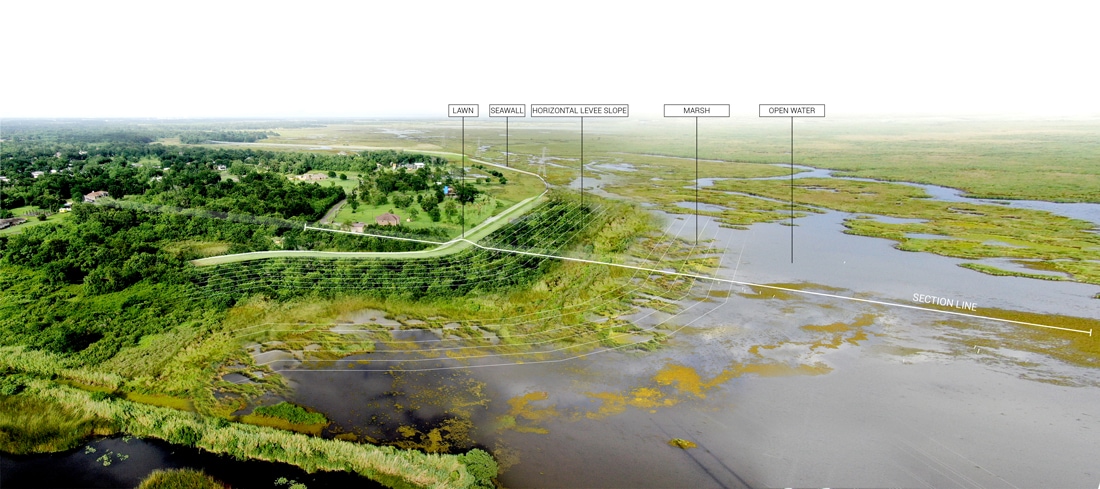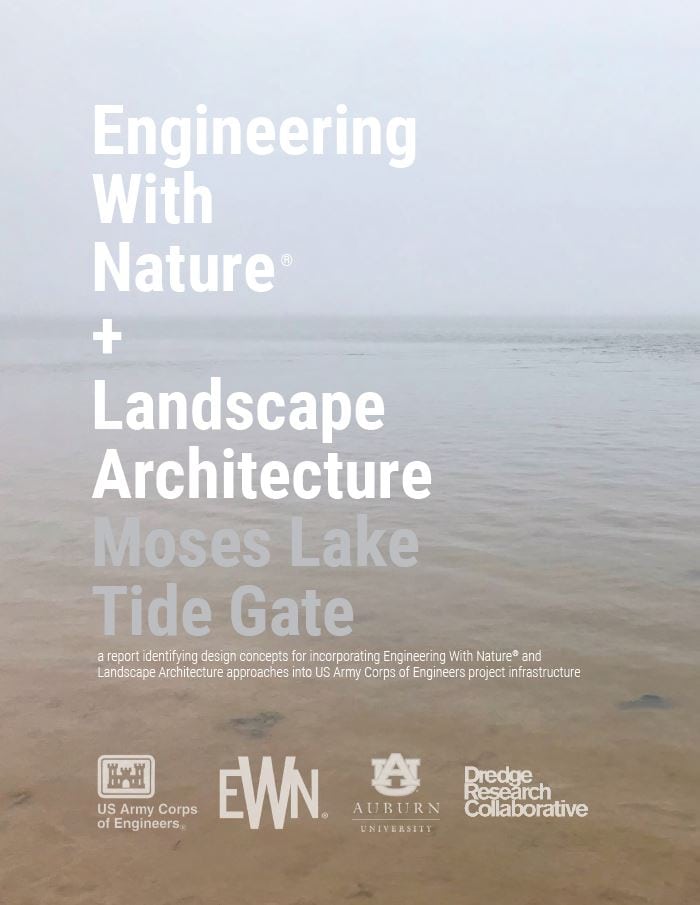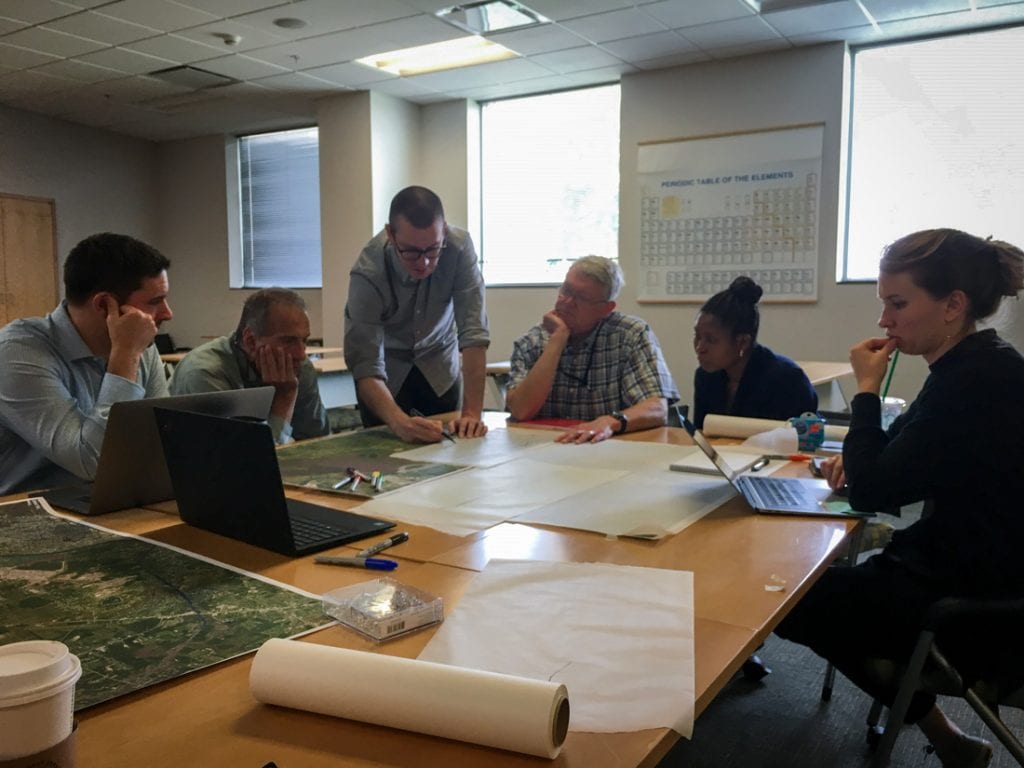This page showcases a range of EWN applications across USACE missions, illustrating how integrated design enhances functionality, resilience, and long-term benefits. Explore innovative approaches and visualize what’s possible.
Our multidisciplinary team is advancing innovative approaches for USACE infrastructure projects, meeting engineering objectives while delivering broader benefits. Through workshops and engagements, we’ve translated EWN concepts into drawings, renderings, and reports that illustrate real-world applications. Explore this page and related reports to discover EWN opportunities, and check back for updates on new designs and insights.

USACE project teams are applying EWN principles and landscape architecture techniques to enhance infrastructure projects. These reports capture their ideas, approaches, and outcomes—demonstrating how thoughtful design can create lasting economic, social, and ecological benefits.
A report identifying design concepts for incorporating Engineering With Nature® approaches into the work of the Buffalo, Chicago, and Detroit Districts
A report identifying design concepts for incorporating Engineering With Nature® approaches into the work of the Mobile District
A report identifying design concepts for incorporating Engineering With Nature® approaches into the work of the Philadelphia District
A report identifying design concepts for incorporating Engineering With Nature® approaches into the work of the San Francisco District
Beginning in July 2019, the Engineering With Nature® and Landscape Architecture project delivery team (EWN®-LA PDT) participated in a workshop hosted by the USACE’s Philadelphia District (NAP) in which an array of potential NNBF design concepts and EWN strategies were developed for further consideration. Seven design concepts were prioritized to include more details, and these designs were then further refined during additional study and analysis. Over the next nine months, these concepts were evaluated with respect to application in the NJBB regions. The report details the results of those findings and also includes possible methods for pairing NNBF with non-structural measures to obtain coastal storm risk management (CSRM) and ecological benefits.
This R&D report offers information on the innovative design concepts that were identified for components of the Sabine to Galveston (S2G) Project, which is a project of the Galveston District (SWG), US Army Corps of Engineers (USACE). These design concepts combine Engineering With Nature® (EWN®) and landscape architectural (LA) approaches to infrastructure design in order to identify opportunities to incorporate “Natural and Nature-Based Features” (NNBF) into proposed S2G Project infrastructure.
In fall 2018, the Engineering With Nature® and Landscape Architecture project delivery team (EWN®-LA PDT) began working with New Orleans District (MVN), USACE to develop recommendations for how the on-going design and construction of the canal might incorporate EWN® principles and NNBF. This R&D report offers information on the innovative design concepts that were identified for Comite Canal.
In fall 2018, the Engineering With Nature® and Landscape Architecture project delivery team (EWN®-LA PDT) began working with Jacksonville District (SAJ), USACE to develop recommendations for how the W.P. Franklin Lock and Dam project area and Moore Haven Lock and Dam project area might incorporate EWN principles and NNBF. This R&D report offers information on the innovative design concepts that were identified for these two project areas.
In fall 2018, the Engineering with Nature® and Landscape Architecture project delivery team (EWN®-LA PDT) began working with the Baltimore District of the US Army Corps of Engineers to develop recommendations for repairing jetties in Chesapeake Beach, Maryland, at the mouth of Fishing Creek; and in Annapolis, Maryland, at the mouth of Back Creek. This study has examined alternative options, which are intended to both maintain the navigation-related performance criteria for the jetties and to provide enhanced ecological value on or in the vicinity of the jetties.

In January 2019, the Engineering with Nature® and Landscape Architecture project delivery team (EWN®-LA PDT) began working with Galveston District of the US Army Corps of Engineers to develop recommendations for protecting the shoreline areas near the Moses Lake Tide Gate. This study examined options for increasing resilience in the vicinity of the tide gate while also integrating additional ecological and social benefits. This R&D report offers information on the design concepts that were identified for the project area.
Landscape architecture (LA) renderings are a powerful tool for visualizing how a project integrates with its surroundings. Using standard techniques—such as plan views, section elevations, and aerial perspectives—these renderings illustrate key aspects of a project, from engineering benefits to recreational use and habitat development.
They also enable before-and-after comparisons, helping decision-makers, planners, and the public better understand anticipated changes. The following designs and renderings, drawn from EWN/LA reports, are available as standalone files to support the illustration of EWN techniques.
EWN integrates natural and engineering processes to enhance water-based infrastructure projects. Bringing landscape architects (LAs) into the team adds another dimension—expanding design possibilities and improving how projects connect with people and nature.
LAs translate concepts into visuals, using a shared design language to communicate how natural processes can be woven into traditional engineering. This collaborative approach unites engineers, hydrologists, biologists, ecologists, and landscape architects in advancing EWN strategies.

We appreciate the Dredge Research Collaborative (DRC) for their partnership in developing many of the renderings and reports featured on this page. Since 2017, DRC members—including Rob Holmes, Sean Burkholder, Brian Davis, Justine Holzman, and Gena Wirth—have collaborated with ERDC scientists and engineers to integrate EWN concepts into water resources infrastructure.

Engineering With Nature® is the intentional alignment of natural and engineering processes to efficiently and effectively deliver economic, ecological, and social benefits through collaboration.